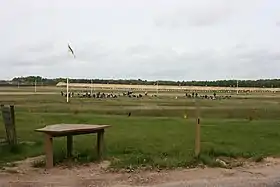National Shooting Centre
The National Shooting Centre located near the village of Bisley in Surrey from which it takes its colloquial name "Bisley ranges" it is wholly owned by the National Rifle Association of the United Kingdom (NRA). The NSC is the trading name of the facility.[1]

In 1890, the village became the location for the NRA Imperial Meeting (the Association's National Championship), which moved there from Wimbledon, London. The competition is hosted on the ranges at Bisley Camp having outgrown the Wimbledon Common ranges which had previously been used. The NRA of the UK also moved its headquarters from London to Bisley Camp.[2] Bisley hosted most of the shooting events in the 1908 Olympic Games, and all the shooting for the 2002 Commonwealth Games.[3] During the 2012 Olympic Games the shooting was held at the Royal Artillery Barracks, Woolwich.
As well as the rifle ranges, there are two clay target shooting complexes; The National Clay Shooting Centre, which caters for 'trap' disciplines such as Skeet and DTL, and Bisley Shooting Grounds, which caters for sporting clays, or simulated game shooting. Bisley is famous within shooting circles and has a long history. Some of the buildings within the grounds are from the Victorian era, having been transported there in the re-location from Wimbledon Common. The camp also once had its own railway branch line which ran from nearby Brookwood station, and was known as the 'Bisley Bullet'.[4][5]
In 1894 Colt, the US firearms manufacturer, introduced and sold the Bisley Model of its famous Single Action Army revolver specifically designed for target shooting. This revolver featured a longer grip, a wider hammer spur, a wider trigger and adjustable sights. It was offered in a variety of calibres including .32–20, .38–40, .45 Colt, .44-40.[6][7][8]
It is also the location of Army Operational Shooting Competition, in which members of the British army compete for the Queen's Medal.
Ranges
The National Shooting Center has a number of ranges to cater for differing firearms and shooting disciplines.
Short Siberia
Short Siberia is the situated furthest away from the Range Office at the end of Hobson's way, which is the Road at the back of Century Range. It is a rifle range with 27 x 100 yard targets and 9 x 200 yard targets.
Century Range
Century Range was the first range built at Bisley when the NRA moved here in 1890. It has 108 targets and firing points at distances between 100 and 600 yards. Century Range is also the home of the 300m discipline and the new NRA electronic targets at Butt 19.
Stickledown Range
The longest range on the Bisley Complex, Stickledown is a Gallery Range with 50 targets to be shot at distances from 800 to 1200 yards. Stickledown is also the home of the Bisley Buffalo. Following successful trials in the Spring of 2017, the NRA have purchased 11 electronic targets that have been installed on Stickledown.
The Bisley Buffalo
The NRA has installed a steel silhouette of a buffalo on its Stickledown range, allowing Bisley shooters the chance to use a reactive target at long range for the first time. “Target 51” on Stickledown consists of a 2.4m x 1.7m steel buffalo silhouette, painted white. It is available from 800yds, 900yds and 1,000yds and was installed after consultation with the Single Shot Black Powder Cartridge Rifle Club of Great Britain. Any rifle that fits within the existing Stickledown range restrictions may be used to engage the buffalo.
Zero Range
This range is 71’ 7” in distance and is available for fullbore rifle prone shooting only. This range is only available to shooters who are also booked to use another range, as it is intended solely for the safe zeroing of a rifle prior to use. This range has 4 prone-only bays.
Melville Range
Melville range has a total of 5 bays. One bay contains 8 targets with retrievable mechanisms out to 50m. Four bays offer gallery rifle and pistol turning targets at 25 and 50 metres. Gallery rifles and pistols** only can be shot on this range. Prone .22 calibre rifles can be shot by special arrangement.
Cheylesmore Range
Cheylesmore Range is a 25m no danger area range for gallery rifles and pistols.
Range Restrictions
Rifle Restrictions
A maximum muzzle velocity of 1000 m/s (3280 ft/s), A maximum muzzle energy of 4500 J (3319 ft lb).[1]
Gallery Rifle and Pistol Restrictions
A maximum muzzle velocity of 655 m/s (2150 ft/s), A maximum muzzle energy of 2030J (1496 ft lb).[1]
High Muzzle Energy Firearms Restrictions
A maximum muzzle velocity of 1000 m/s (3280 ft/s), A maximum muzzle energy of 7000 J (5160 ft lb).[1] For these there are additional zeroing procedures
See also
- Shooting sport
References
- "Range Regulations". NRA. Retrieved 2020-02-22.
- NRA Official History Archived 31 May 2015 at the Wayback Machine
- 1908 Summer Olympics official report. p. 254.
- Iain Wakefield (16 June 2017). "The Bisley Bullet Bites The Dust" (PDF). Woking History. Archived from the original (PDF) on 27 August 2020. Retrieved 27 August 2020.
- "Bullet train to Bisley". Woking News & Mail. Woking News & Mail. 15 March 2020. Archived from the original on 16 March 2020. Retrieved 27 August 2020.
- Wiley Clapp (10 July 2012). "The Colt Bisley". American Rifleman. National Rifle Association of America. Archived from the original on 5 March 2018. Retrieved 27 August 2020.
- Alan Garbers (2019). "The Bisley Revolver". Guns Magazine. FMG Publications. Archived from the original on 22 August 2019. Retrieved 27 August 2020.
- Model Guns